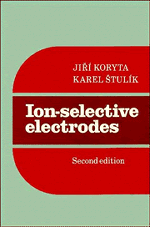Book contents
- Frontmatter
- Contents
- Preface
- 1 Introduction
- 2 The theory of membrane potentials
- 3 The theory of membrane potentials in ion-selective electrodes
- 4 Principal properties of ion-selective electrodes
- 5 Experimental techniques
- 6 Ion-selective electrodes with solid or glassy membranes
- 7 Ion-selective electrodes with liquid membranes
- 8 Potentiometric biosensors
- 9 Voltammetry at the interface of two immiscible electrolyte solutions
- Appendix
- Index
1 - Introduction
Published online by Cambridge University Press: 05 November 2011
- Frontmatter
- Contents
- Preface
- 1 Introduction
- 2 The theory of membrane potentials
- 3 The theory of membrane potentials in ion-selective electrodes
- 4 Principal properties of ion-selective electrodes
- 5 Experimental techniques
- 6 Ion-selective electrodes with solid or glassy membranes
- 7 Ion-selective electrodes with liquid membranes
- 8 Potentiometric biosensors
- 9 Voltammetry at the interface of two immiscible electrolyte solutions
- Appendix
- Index
Summary
There is a tendency in many fields of contemporary physical and chemical science to seek impulses from biology for solving problems. This tendency shows promise, not only because it leads to new artificial tools, materials or processes, but also because it forms models permitting deeper understanding, at least in certain areas, of the actual processes occurring in nature. Efforts to imitate nature thus facilitate its deeper understanding.
Ion-selective electrodes are a remarkable product of this approach. Their development can be followed in several circular pathways from natural bioelectric phenomena to artificial membrane systems and back again, to attempts to explain processes at a cellular level.
The relationship between electric and physiological processes was discovered in 1791 by L. Galvani [27] in his classic experiments with frog muscles and nerves. In spite of these exciting results, the study of electrophysiological phenomena did not progress for several decades. M. Faraday [99] studied the electricity produced by the torpedo, but only in order to prove that this ‘animal’ electricity is the same as other kinds of electricity, for example ‘voltaic’ electricity from an electric machine or ‘galvanic’ electricity from a galvanic cell.
In 1848 du Bois-Reymond [21] suggested that the surfaces of biological formations have a property similar to the electrode of a galvanic cell and that this is the source of bioelectric phenomena observed in damaged tissues. The properties of biological membranes could not, however, be explained before at least the basic electrochemistry of simple models was formulated.
- Type
- Chapter
- Information
- Ion-Selective Electrodes , pp. 1 - 7Publisher: Cambridge University PressPrint publication year: 1983



